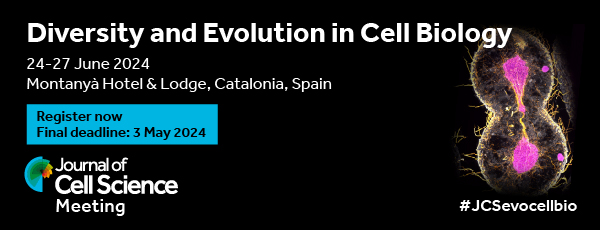Issues
-
Cover image
Cover Image

Cover: Endothelial cells on micropatterned surfaces. The presence of transcription factors MRTF (green) and YAP (cyan) in the nucleus is independent of cell shape. Nuclei are stained with Hoechst 33342 (blue), F-actin is stained with Rhodamine-phalloidin (red). See article by F. A. Gegenfurtner et al. (jcs212886).
- PDF Icon PDF LinkTable of contents
- PDF Icon PDF LinkIssue info
RESEARCH HIGHLIGHTS
FIRST PERSON
CELL SCIENTISTS TO WATCH
OPINION
The path to VICTORy – a beginner's guide to success using commercial research antibodies
Summary: Much anguish, talent, time and money are expended on cell biology using inadequately characterized commercial research antibodies, and this can lead to bad science. I summarize the situation and suggest accessible solutions.
REVIEW
How alternative splicing affects membrane-trafficking dynamics
Summary: This Review summarizes how trafficking is molecularly influenced by alternative splicing and how this interplay impacts physiology and pathological conditions.
SHORT REPORTS
A systematic survey of conformational states in β1 and β4 integrins using negative-stain electron microscopy
Summary: A systematic structural analysis using negative-stain electron microscopy on many different β1 and β4 integrins showed no large ‘switchblade-like’ conformational change coupled to their affinity states.
Phosphorylation of XIAP at threonine 180 controls its activity in Wnt signaling
Summary: Threonine 180 is a critical site on XIAP that directs the activity of XIAP in Wnt signaling, but not apoptosis, allowing for the possibility of designing Wnt-specific therapeutics that target this site.
The GET pathway can increase the risk of mitochondrial outer membrane proteins to be mistargeted to the ER
Summary: The GET machinery can, in principle, process mitochondrial proteins but, under normal conditions, active mitochondrial targeting pathways dominate the kinetic competition against GET recognition.
RESEARCH ARTICLES
Multiple roles of epithelial heparan sulfate in stomach morphogenesis
Summary: Heparan sulfate is highly expressed in the embryonic mammalian stomach and is required for gastric development, including stratification of forestomach and specification of glandular stomach.
BAMBI is a novel HIF1-dependent modulator of TGFβ-mediated disruption of cell polarity during hypoxia
Summary: Hypoxia disrupts the polarity of MDCK cysts in a HIF1α-dependent manner by modulating the TGFβ pathway. BAMBI is identified as a novel HIF1-regulated gene that contributes to the hypoxia-induced polarity defect.
The VLDL receptor regulates membrane progesterone receptor trafficking and non-genomic signaling
Summary: VLDLR is a chaperone important for membrane progesterone receptor (mPR) trafficking and is required for non-genomic progesterone signaling.
14-3-3 proteins regulate desmosomal adhesion via plakophilins
Summary: Growth factor signaling regulates the phosphorylation-dependent association of plakophilins 1 and 3 with 14-3-3 isoforms, revealing partially antagonistic functions of 14-3-3 proteins in the regulation of desmosomes.
Activated ezrin controls MISP levels to ensure correct NuMA polarization and spindle orientation
Summary: Activated ezrin controls cortical MISP levels, which are necessary for proper NuMA polarization at the cortex and, hence, precise spindle orientation.
Lysosome enlargement during inhibition of the lipid kinase PIKfyve proceeds through lysosome coalescence
Summary: PIKfyve inhibition causes lysosomes to coalesce, resulting in fewer, enlarged lysosomes; TFEB-mediated lysosome biosynthesis does not contribute to swelling.
Expansion of DUB functionality generated by alternative isoforms – USP35, a case study
Highlighted Article: An analysis of USP35 shows that alternative isoforms can substantially contribute to expanding the functionality of deubiquitylating enzymes, hence allowing them to regulate multiple intracellular ubiquitylation events.
Tissue stiffening promotes keratinocyte proliferation through activation of epidermal growth factor signaling
Summary: Increased matrix stiffness promotes keratinocyte proliferation through activation of the epidermal growth factor receptor both in vitro and in keloid scars.
Mitochondrial cAMP exerts positive feedback on mitochondrial Ca2+ uptake via the recruitment of Epac1
Highlighted Article: The Ca2+-dependent formation of mitochondrial cAMP by matrix-localized soluble adenylyl cyclase intensifies further Ca2+ uptake into the organelle; this convergence of signalling pathways supports steroidogenesis.
The Ajuba family protein Wtip regulates actomyosin contractility during vertebrate neural tube closure
Highlighted Article: Wtip is a tension-sensitive cytoskeletal adaptor that binds Shroom3 and modulates Shroom3-dependent apical constriction during Xenopus neurulation.
TOOLS AND RESOURCES
SunRiSE – measuring translation elongation at single-cell resolution by means of flow cytometry
Highlighted Article: A novel method to measure translation elongation rate and intensity in complex and heterogeneous cell populations by combining puromycilation, translation run-off experiment and flow cytometry detection is presented.
Micropatterning as a tool to identify regulatory triggers and kinetics of actin-mediated endothelial mechanosensing
Summary: A specifically tailored set of micropatterns is used as a cell biological tool to study the regulation of mechanosensitive transcription factors in an angiogenesis model.
RNAi screening identifies a mechanosensitive ROCK-JAK2-STAT3 network central to myofibroblast activation
Summary: Myofibroblasts are key drivers of fibrosis. Here, RNAi screening is used to identify novel regulators of myofibroblast activation, and a matrix-stiffness-dependent STAT3 activation pathway is identified.
CORRECTIONS
Introducing our new Editors

We welcome three new Editors to Journal of Cell Science - Robert Parton, Richa Rikhy and Simon Cook. You can read more about them in the Editorial from our Editor-in-Chief Michael Way.
2024 Journal Meeting 'Diversity and Evolution in Cell Biology'

Registration is open for our 2024 Journal Meeting Diversity and Evolution in Cell Biology, which aims to bring together evolutionary biologists and cell biologists investigating diverse aspects of cellular physiology. Final registration deadline: 3 May 2024.
Workshop: Physics of the Early Embryonic Cell Divisions

Early-career researchers interested in the roles of nuclear lipids, apply now for one of the ten funded places at this Workshop, which will take place 11-14 November 2024. Application deadline: 17 May.
Reasons to submit to Journal of Cell Science

There are many benefits to publishing in Journal of Cell Science - read more about why you should choose JCS or visit our submission page now.
Propose a new Workshop for 2026

We are now accepting proposals for our 2026 Workshops programme. We aim to be responsive to the community and open to novel initiatives, so if you have a new idea for a biological workshop that you feel would work well, please apply. Applications deadline: 19 July 2024.



